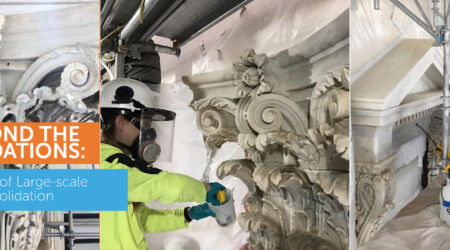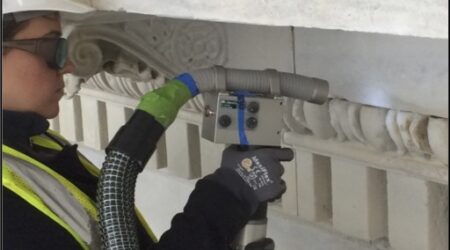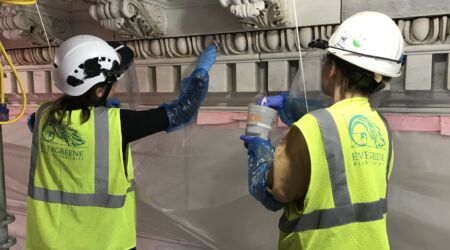Presented at the International Symposium CONSOLIDATION 2021
Stone Consolidation in Cultural Heritage| LNEC | Lisbon, Portugal
March 25, 2022
Authors:
Kelly Caldwell, Director of Conservation
Emma Kousouris, Asst. Project Manager / Conservator
With the integration of chemical consolidation into the standard toolbox for stone, difficulties with large-scale application are emerging for conservators. While its mechanical properties have been widely researched, practical implementation is often not evaluated outside laboratory or small-scale applications.
The purpose of this presentation is to share the experiences and lessons learned when confronting the implementation of consolidation on a large scale. The authors’ goals are to provide the groundwork for what to expect and how to approach anticipated challenges, even setbacks, to better prepare contemporaries that may take on this task.
The presenters are speaking from personal experience with consolidation of white, carved marble using a hydroxylating conversion treatment followed by ethyl silicate consolidation. Techniques have evolved while working at the Russell Senate Office Building, Washington, DC, Vermont Marble at the Carnegie Library, Washington, DC, and Lee, Cockeysville, Georgia, and Vermont marbles at the U.S. Capitol, North and South Extensions, Washington, DC. While this is the basis of their experience, the overall themes can be applied to other consolidants applied to a range of stone substrates at a large scale.
Chemical consolidation poses logistical challenges when applied at a building scale. Those challenges break down into four categories during large-scale implementation: site protection, training, application, and environmental controls. These considerations are critical to a successful consolidation treatment. When approaching a major consolidation project, it is important to have realistic expectations on the goals and the implementation. By setting expectations for the whole team, everyone will be able to anticipate the obstacles and be ready to problem solve as challenges arise.
The site protection for collection of runoff and protection of surrounding materials and the public is the most time-consuming aspect consolidation that has been refined over many projects. This presentation will discuss the evolution of EverGreene’s large-scale site protection, including storage of chemicals, containment of chemical runoff, and protection of surrounding areas during chemical preparations.
In order to achieve the most desirable results, consolidation treatments must follow technical guidelines given by the manufacturer as closely as possible. The specifications are typically replicating testing methods achieved in a lab setting. The crew on site must adhere to the specifications to achieve “laboratory” results. This requires the crew to understand the timing, application technique, and restrictions related to the treatments (i.e. exposure to sunlight, water, temperatures). The crew does not necessarily need to be educated on the chemical reactions that are occurring, but they need to have enough understanding in order to recognize the importance of the restrictions specified. We will review our approach to staff training and awareness.
Controlling the environment on a multi-level scaffolding presents challenges that both conservators and contractors are unaccustomed to handling. EverGreene has explored communication techniques such as “call and responses”, hand signals, and flags to coordinate staff across scaffolding. Consolidating year-round has forced staff to think of creative ways to maintain temperature and relative humidity.
Standardization has become a double-edged sword. The nature of specifications has made it difficult to meet the rigid contract requirements that are common on large-scale construction projects. Second to this, increased environmental awareness and a comprehension of the dangers of the consolidation chemicals is needed to enhance current site protection and material handling practices. Often, these structures remain occupied and the health and safety of both workers and occupants must be evaluated.
Another factor to evaluate is the scientific and technical nature of chemical consolidation. These elements, so familiar to conservators, must be addressed and understood by professionals outside the field of conservation. This poses its own challenges to ensure a collaborative outcome. Different levels of communication with both stakeholders and staff is required during the pre-project planning and implementation phases during the project. The balance communicating both the technical aspects of consolidation and the logistical concerns will be discussed.
This presentation will discuss our team’s collective experience in North America with the application of chemical consolidants on large-scale masonry façades. We will review successes and failures in methodology with a focus on the four main logistical challenges (training, site protection, application, and environmental). Lastly, we will discuss our recommendations for future applications. KEY-WORDS: large-scale, lessons learned, managing expectations.
References:
Clifton, James R. “NBS Technical Note 118: Stone Consolidating Materials – a Status Report.” U.S. Department of Commerce, National Bureau of Standards, May 1980. https://nvlpubs.nist.gov/nistpubs/Legacy/TN/nbstechnicalnote1118.pdf.
Ferguson, Eric, and CA Price. Stone Conservation: An Overview of Current Research. Los Angeles, Calif: Getty Conservation Institute, 2010. https://www.worldcat.org/title/stone-conservation-an-overview-of-current-research/oclc/614397594&referer=brief_results.
Ferreira, A.P., and J. Delgado Rodrigues. “Stone Consolidation: The Role of Treatment Procedures.” Journal of Cultural Heritage 9, no. 1 (March 2008): 38–53.
Lai, Constance. “Construction and Conservator Safety.” AIC News, September 2014.
Nishiura, T. Relationship between the moisture content of stone and the hydrophobic effect of silane treatment: Studies on the conservation treatment of stone (IV). In Conservation and Restoration of Stone Monuments: Scientific and Technical Study on the Conservation and Restoration of Monuments Made of Stone or Related Materials, ed. Y. Emoto, T. Nishiura, and S. Miura, 101-4. Tokyo: Tokyo National Research Institute of Cultural Properties, 1985. [Japanese with English summary]
Oliver, A. B. The variable performance of ethyl silicate: Consolidated stone at three national parks. APT Bulletin 33(2-3):39-44.
Rossi-Manaresi, R. Treatments for sandstone consolidation. In the Conservation of Stone I, ed. R. Rossi-Manaresi, 547-71. Bologna: Centro per la Conservazione delle Sculture all’Aperto, 1976.
Warrack, Simon. “From the Laboratory to the Site: Considerations on the Relationship between Research and Practice.” LNEC, 2008.
Wheeler, George. Alkoxysilanes and the Consolidation of Stone. Research in Conservation. Los Angeles, Calif: Getty Publications, 2005.











